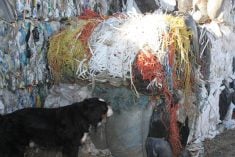REGINA — Every once in a while a family is rewarded for decades of hard work and a common sense approach to raising cattle.
That was the case for Danny and Conna Warrilow of Minburn, Alta,. when they sold a half interest in an eight-month-old Red Angus bull calf for $67,000 at Canadian Western Agribition in Regina.
Red Minburn Copenhagen 3Y will be owned in partnership with Silver Spurs Ranch of Encampment, Wyoming, Heart of the Valley Farms of Courtney, B.C. and U2 Ranch of Coaldale, Alta.
Read Also

Message to provincial agriculture ministers: focus on international trade
International trade stakeholders said securing markets in the face of increasing protectionism should be the key priority for Canada’s agriculture ministers.
The bull caught the eye of buyers looking for outcross genetics.
“He was just interesting right from the word go,” Conna said.
The calf was from a home-raised, high-performing black cow that they decided to flush and mate with a red bull. All the resulting calves were red.
They also sold a full sister heifer calf for $5,800 at the Agribition Masterpiece sale, which totalled $275,500 and averaged $6,406 on 43 lots.
“We had done this embryo treatment just to use for ourselves and so when this calf came out and a couple of people saw him, and right away, they said, ‘wow, what a calf.’ It was difficult to put him in the sale,” said Danny.
The calf goes to stud in February and has a number of full sisters, but they must produce good calves before they enter an embryo flushing program.
“We don’t flush anything at our place unless it has proven itself to be a good cow. His sisters won’t go into an ET program at our place until they have proven themselves worthy of that,” he said.
The sale was the highlight of the Warrilows’ career, although they also recorded their best on-farm production sale this year since 2003.
Times got tough when BSE struck a few months after their March 2003 bull sale, but they decided to continue the production sales rather than lose some of their best commercial customers.
While the last year has seen the good times return, Danny said they need many good years to recover what was lost.
“We are still not at the place we were 10 years ago,” he said. “We’ve got 10 years to make up for the money we lost. The guys who are still in there lost a lot of money in the last eight years and so times can get good but they need to get ridiculously good for a long time just to catch up.”
The Warrilows stopped running their female production sales in 2008 but continue to sell some privately. Commercial bred females are commanding higher prices at auction these days, but the purebred sector is slower to respond to market signals.
“There is a demand for females and there is a better price, but it is not the same percentage jump as what the commercial cattle are doing right now. We just have to be satisfied to wait for that for one more year.”
The Warrilows live entirely off their 300 head of purebred cattle, which are raised in the hard grass region of northeastern Alberta.
“They are purebred but they are ranch cows,” he said.
“If we treated them too good, then our bull customers wouldn’t be happy. They come to our place to buy bulls to produce offspring that are going to work in their conditions.”
The Warrilows were early adopters of swath grazing and extending their grazing season as long as possible to cut costs on overwintering cows.
“We don’t start feeding our cows manually until February when we start calving,” he said.
“We usually pasture them till the middle of November on grass and then they go to swath grazing for two to two and a half months.”
It works best with deep snow cover to keep the oat swaths fresh. It also forces the cows to dig through the snow and eat the entire row. They waste about five percent.
The cows stay in the fields until calving, when the Warrilows upgrade the feed quality.
“When we first started there wasn’t much literature on it. I started with 15 acres because I didn’t believe it would work. I couldn’t believe how those cows cleaned it up,” he said.
“It’s not the cost of putting the feed up. It’s the cost of hauling the feed out to the cows.”















